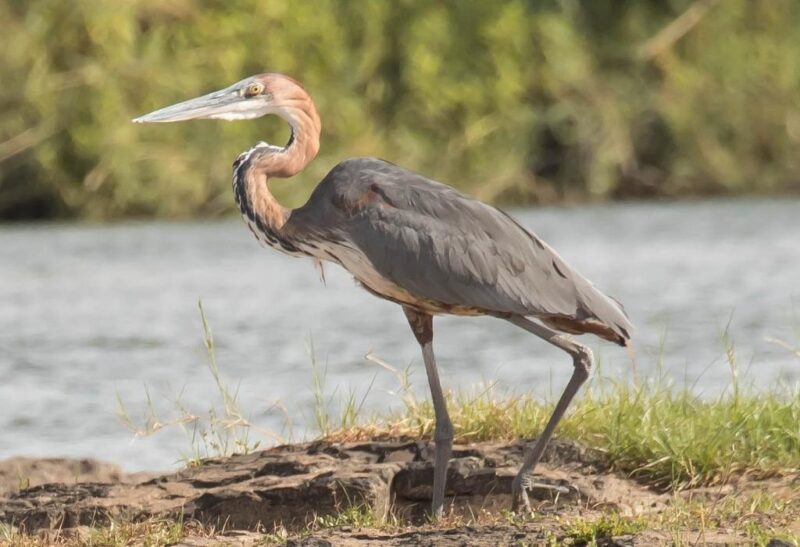Birds are often revered for their majestic wings as they soar through the skies. However, what bird watchers and enthusiasts are also in awe of are those that have unusual beaks that are more elongated than normal.
Different birds with long beaks include the Goliath Heron, Long-billed Curlew, Northern Jacana, Far Eastern Curlew, Hudsonian Whimbrel, Roseate Spoonbill, Red Crossbill, Southern Giant Petrel, Black Skimmer, Southern Yellow-billed Hornbill, Collared Aracari, and more!
If you want to know more about birds with long beaks, their physical attributes, food preferences, and distinctive characteristics, look no further, as this article will provide you with everything you need to know!
Table of Contents
What Are Long Bird Beaks Used For?
Birds use their long beaks for foraging, capturing, and eating prey and food. Their beaks are indications that these birds have naturally adapted to their environment and increased their chances of survival in the wild.
For example, pelicans are characterized by their long, pouched beaks, which are used as nets to scoop fish up. Hummingbirds, on the other hand, use their elongated, needle-like beaks to sip nectar that is deep inside flowers.
Moreover, shorebirds use their long, probing beaks to probe into sand, shallow waters, and mud for food. There are also long beaks that are specialized, such as that of the flamingos, which are shaped like commas and are used for filter-feeding.
22 Birds With Long Beaks
Goliath Heron
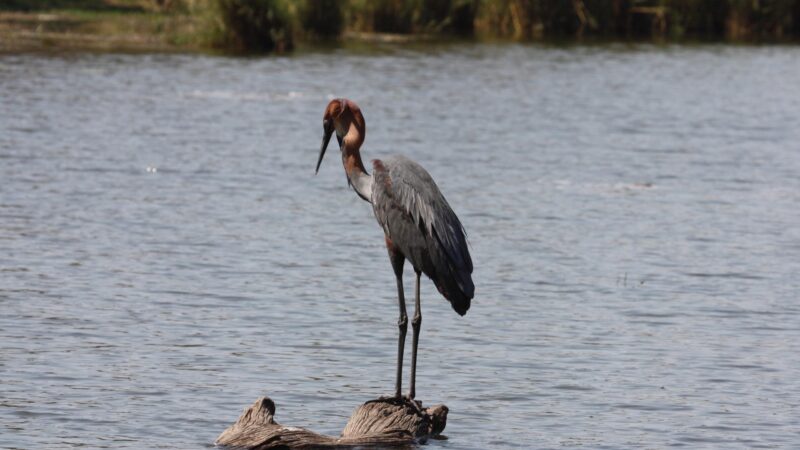
Considered the largest species of all living herons, Goliath Herons reside in shallow saltwater and freshwater habitats such as rivers, marshes, and lakes. They have an undeveloped sense of smell and are generally skittish birds, especially when threatened.
- Scientific Name: Ardea goliath
- Appearance: A large bird with an elongated head, breast, neck, wings, and dagger-shaped beaks
- Color: Grayish-purple plumage with rufous coloration or patches on its head, breast, and neck. Its neck has a black vertical line (sometimes just black patches) with white or cream patches.
- Beak Length: 24 centimeters
- Lifespan: Up to 15 years (wild), up to 22.5 years (captivity)
- Size: 1.2 to 1.5 meters
- Weight: 4.3 to 5 kilograms
- Diet: Primarily large fish of up to 30 centimeters in length and weighing 500 to 600 grams. They also feed on prawns, carrion, and amphibians.
- Place Of Origin: Africa
- Characteristics: They are nocturnal and sedentary birds but may move to new hunting areas with more favorable conditions. Solitary, except during breeding season, but are occasionally in pairs. Not territorial but will defend their habitats against predators.
Long-Billed Curlew

Long-billed Curlews are the largest shorebirds found in North America and are usually found standing tall at tidal mudflats, on shortgrass prairies, and even on beaches. They’re considered in danger of extinction, according to the 2016 North America’s Birds Watch List.
- Scientific Name: Numenius americanus
- Appearance: A large and long-legged shorebird with a football-shaped body, small round head, thin but long and curved beak, distinctive wing coverts, and long neck
- Color: Varying shades of brown plumage with brown streaks and bars throughout its head and body. Its flight feathers are a strong cinnamon color with distinguishable dark brown-centered wing coverts. Their lower beak has a pink base.
- Beak Length: 19 centimeters
- Lifespan: 8 to 10 years (wild)
- Size: 50 to 65 centimeters
- Weight: 490 to 950 grams
- Diet: Primarily insects (e.g. grasshoppers, beetles, and spiders), small marine invertebrates, and crustaceans. They like to forage for deep-burrowing animals such as earthworms, crabs, and shrimp.
- Place Of Origin: North America
- Characteristics: Diurnal and migratory. They also travel short distances between foraging sites. They’re primarily solitary unless breeding. However, they form flocks during migration, winter roosts, and when foraging for food. Males are highly aggressive and antagonistic towards other individuals.
Northern Jacana
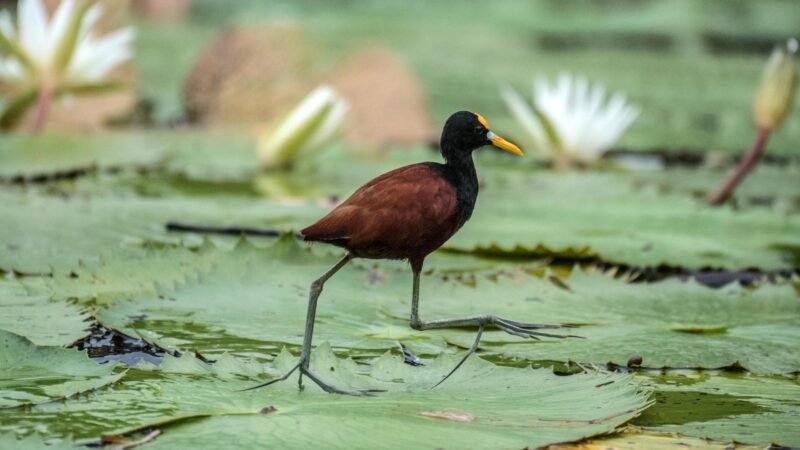
Found in a variety of wetlands with vegetation, Northern Jacanas have an unusual breeding system of resource-defense polyandry. Females will mate with up to 4 males, and both sexes will defend their territories and offspring against other members, as well as predators.
- Scientific Name: Jacana spinosa
- Appearance: Medium-sized shorebirds with long legs and toes and a frontal shield found on the forehead.
- Color: Dark plumage, including the head, neck, and breast. Its undersides, back, and tail are a dark rufous color. They have a yellow beak with a base of white and a distinctive yellow frontal shield.
- Beak Length: 17 to 25 millimeters
- Lifespan: Unknown, but a male was recorded to defend his territory for 6.5 years.
- Size: 24 centimeters
- Weight: 87 to 150 grams
- Diet: Flowers and insects found on aquatic plants. They occasionally feed on small fish.
- Place Of Origin: Range found from Mexico to Panama
- Characteristics: Diurnal and highly social. They’re found in small colonies composed of a dominant female and up to 4 males.
Far Eastern Curlew

Far Eastern Curlews, or simply Eastern Curlews, are the largest migratory sand bird known to travel lengthy distances of over 12,000 kilometers. Chicks leave their nests as early as 6 to 8 weeks old for their first flight as they’re born with a keen sense of direction and distance.
- Scientific Name: Numenius madagascariensis
- Appearance: A large and bulky body with a large, downward-curving beak
- Color: Dark streaks and/or bars on its grayish brown plumage with a prominent white ring found around the eye and a white throat and chin.
- Beak Length: 15 to 23 centimeters
- Lifespan: Up to 20 years (wild)
- Size: 61 to 66 centimeters
- Weight: 565 grams to 1.15 kilograms
- Diet: Insects and insect larvae, ghost and mantis shrimps, large crabs, mudskippers, prawns, and small mollusks.
- Place Of Origin: East Asia and Australia
- Characteristics: Migratory and solitary but can be seen congregating in small flocks. Easily spooked birds, which makes them extremely wary and susceptible to disturbance.
Hudsonian Whimbrel
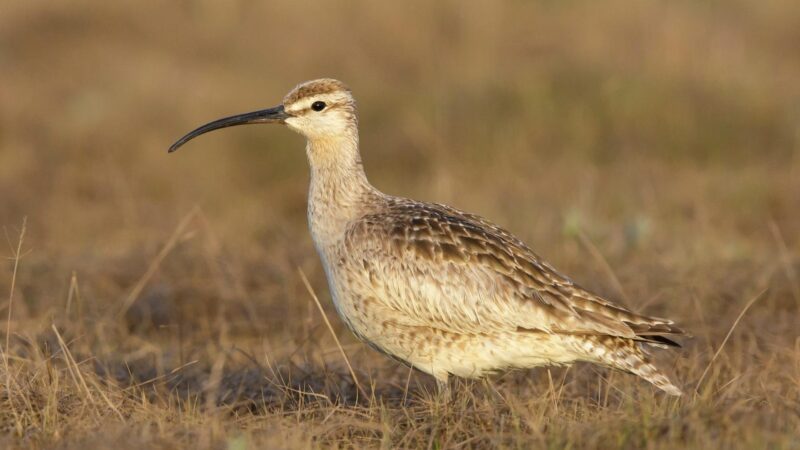
Having one of the widest distribution among curlews, Hudsonian Whimbrels are wading birds that live in open habitats such as mudflats and agricultural lands. Their genus, Numenius, is a Greek word meaning “new moon,” which references their crescent moon-shaped beaks.
- Scientific Name: Numenius hudsonicus
- Appearance: Large shorebird with a robust body, curved bill, lock neck, legs, pointed wings, and a short tail.
- Color: Brownish upper parts that are streaked and have pale feather edges, tan or cream underparts, and a completely brown rump. Its head has a dark brown crown with a distinctive light-colored stripe in its middle.
- Beak Length: 10 to 13 centimeters
- Lifespan: Unknown
- Size: 37 to 47 centimeters
- Weight: 270 to 493 grams
- Diet: Mainly marine invertebrates and a variety of crabs such as fiddler crabs, mud crabs, mole crabs, and swimming crabs. They also eat small fish, crayfish, sea cucumbers, marine worms, sand shrimp, insects, and small mollusks. During the fall, they eat berries.
- Place Of Origin: North America
- Characteristics: Migratory and relatively social species that form loose groups during roosting and migration. They’re wary of and susceptible to disturbance.
Roseate Spoonbill
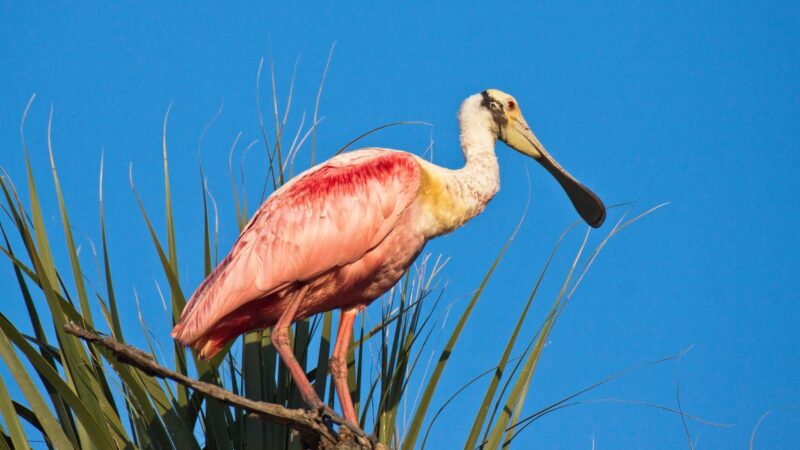
Known for their bright pink coloration and distinguishable spoon-shaped beaks, Roseate Spoonbills are wading birds that can fly with their legs and necks stretched out. They’re usually seen sleeping standing often on one leg or with their head and legs tucked.
- Scientific Name: Platalea ajaja
- Appearance: Medium-sized and football-shaped bodies with long legs and spoon-shaped beaks.
- Color: Overall bright pink plumage with distinctive yellow-green markings on its head, white upper neck and back, and light rose wings and underparts. Its underwings and tail coverts are deep carmines in color, while its legs and shoulder patches are red.
- Beak Length: 10 to 15 centimeters
- Lifespan: Up to 10 years (wild), up to 15 years (captivity)
- Size: 71 to 86 centimeters
- Weight: 1.2 to 1.8 kilograms
- Diet: Small crustaceans, aquatic invertebrates and insects, fish, and minnows
- Place Of Origin: North and South America
- Characteristics: Some are sedentary, and some migrate short distances. They’re often solitary or in pairs, but they roost and migrate in small flocks.
Red Crossbill
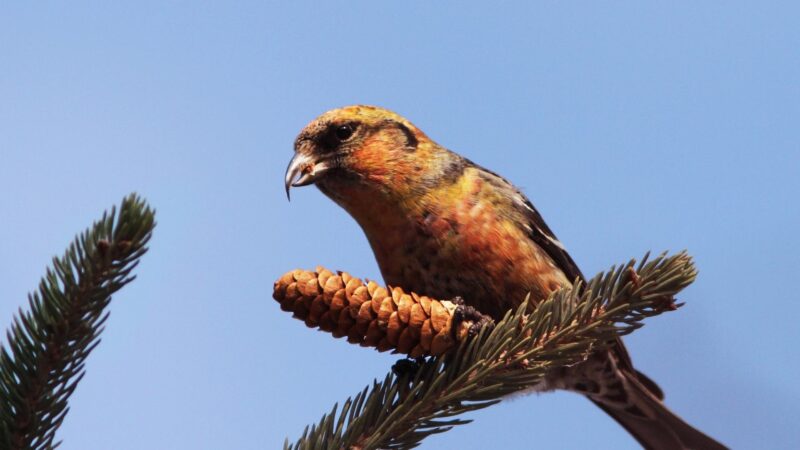
Red Crossbills are characterized by their unusual cross-shaped bills, which is a result of having long and curved mandibles. Due to their beak shape and strength, they are excellent pine cone seed extractors. They can be found in coniferous and mixed deciduous-coniferous forests.
- Scientific Name: Loxia curvirostra
- Appearance: Medium-sized finch with a stocky body, thick and crossed bill, short and notched tail, and pointed wings.
- Color: Males have brick red, rufous, or reddish yellow plumage, while females are greenish-yellow, olive, or gray in coloration. Both have black or dark brown wings and tails.
- Beak Length: 5 to 8 centimeters
- Lifespan: Up to 8 years (captivity), up to 16 years (wild)
- Size: 14 to 20 centimeters
- Weight: 23.7 to 45.5 grams
- Diet: Mainly conifer seeds of larch, spruce, hemlock, pine, douglas-fir trees, and pine cones of a variety of tree species such as pitch pine, red pine, and ponderosa pine. Occasionally, they feed on fallen pine cones on the ground.
- Place Of Origin: Northern Hemisphere
- Characteristics: Sedentary birds that are social and like to live and move in flocks that can reach up to thousands of individuals. They occasionally forage for food outside of their home ranges.
Southern Giant Petrel
Southern Giant Petrels are considered scavengers of the Southern ocean that are extremely active during the day as they flap with heavy wingbeats to forage for food, as well as deliver them to their chicks.
- Scientific Name: Macronectes giganteus
- Appearance: Large-sized flying seabird with hunched backs and hooked beaks
- Color: Has two color morphs: dark and light. Dark morphs have an overall mottled brown plumage, while the head, neck, undersides, and inner wings are lighter. Light morphs have a stark white plumage with black speckles. Both have webbed feat and pale beaks with a tip that’s greenish in color.
- Beak Length: 13 to 15 centimeters
- Lifespan: 20 to 30 years (wild)
- Size: 86 to 99 centimeters
- Weight: 2.3 to 5.6 kilograms
- Diet: Primarily fish and other aquatic animals such as squid, krill, and crustaceans, as well as waste from sea vessels, carrion, and other seabirds
- Place Of Origin: Chile, Australia, Africa, and Antarctica
- Characteristics: Highly aggressive and migrate during the non-breeding season.
Black Skimmer
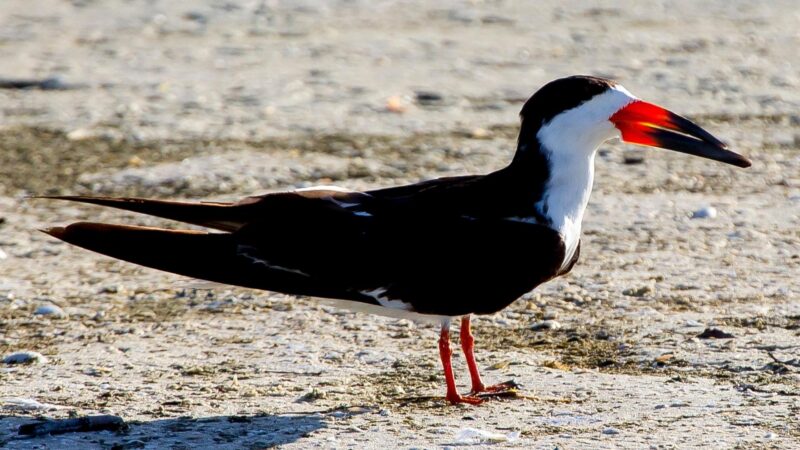
With specialized beaks made for their unique skimming behavior when foraging for food, Black Skimmers are long-winged terns that can be found on ocean beaches and barrier islands. They have a distinguishable barking sound, resembling a nasal “yep” when they fly.
- Scientific Name: Rynchops niger
- Appearance: Medium-sized ternlike coastal waterbird with long wings, short tails, webbed feet, and large laterally-knife-shaped beak wherein the lower mandible is longer compared to the upper mandible by about 2 to 3 centimeters.
- Color: Black upper parts and white underparts and forehead. They have white-spotted tails and bright beaks that are red-orange in color and black-tipped. They have unique, vertical-slitted pupils.
- Beak Length: 8 to 10 centimeters
- Lifespan: Up to 23 years (wild)
- Size: 40 to 50 centimeters
- Weight: 265 to 365 grams
- Diet: Consists mainly of small fish that are 4 to 12 centimeters in length, such as bay anchovies, flounders, and sea trout. They also feed on arthropods and other marine invertebrates.
- Place Of Origin: North America
- Characteristics: Nocturnal, migratory, and social birds that form colonies, consisting of both old and young birds as well as mates. They’re highly territorial and display aggressive posture and behaviors when defending.
Southern Yellow-Billed Hornbill
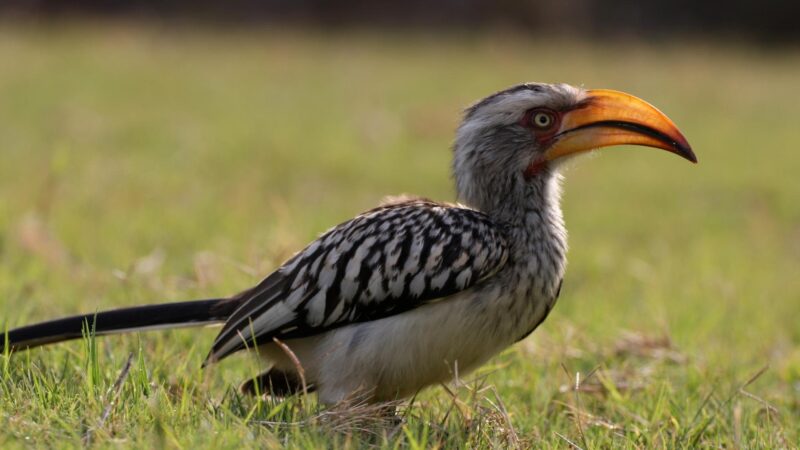
Southern Yellow-billed Hornbills thrive in savannas, semi-deserts, and broadleaved woodlands, but they can also be seen around human camps. They tend to fly to the nearest try when disturbed and are known for their physical displays as a mode of communication.
- Scientific Name: Tockus leucomelas
- Appearance: Medium-sized hornbill with a downward-curving beak comprising about one-sixth of its total body length. It also has a long, rectangular-shaped tail and stubby legs and toes.
- Color: Dominantly white plumage with a mottled and striped black pattern, a distinctive black stripe running down the center of its body, and gray neck and neck spots.
- Beak Length: 9 to 13 centimeters
- Lifespan: Up to 20 years (captivity)
- Size: 48 to 60 centimeters
- Weight: 132 to 242 grams
- Diet: Primarily insects such as termites, grasshoppers, beetles, and caterpillars, but they occasionally feed on small mammals, fruits, berries, nuts, and other bird eggs.
- Place Of Origin: Southern Africa
- Characteristics: Diurnal, territorial, and solitary, but they’re also seen in pairs during breeding and nesting season or in small aggregations during migrations. They’re sedentary but will migrate to find food.
Collared Aracari
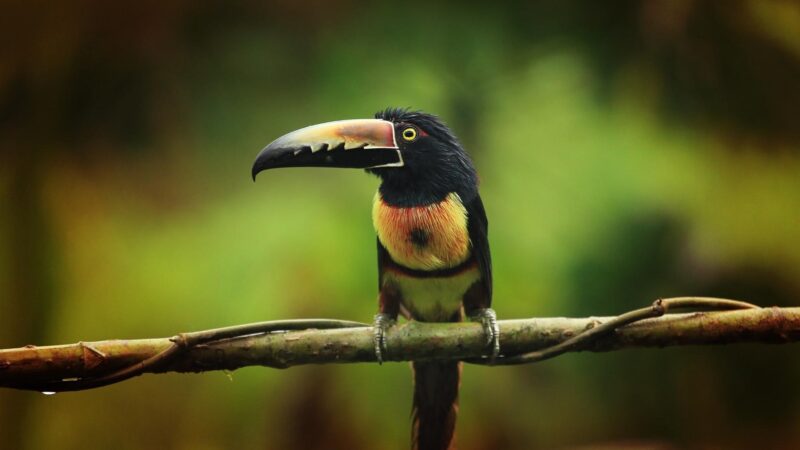
A widely distributed wild toucan, Collared Aracaris are found in humid rainforests or woody lowland forests at elevations of up to 1,500 meters. They’re fast and direct when flying with a distinctive long tail and bill shape with a serrated pattern.
- Scientific Name: Pteroglossus torquatus
- Appearance: Small and slender body with a heavy, hooked bill and long, graduated tail.
- Color: Black with a green hue plumage on its back, throat, and neck. The rump and upper tail are a bright red color, while the belly and undertail are yellow and striped with red and black across the abdomen area. The upper beak is mostly white with a hint of gray, while the lower beak is black.
- Beak Length: 10 centimeters
- Lifespan: Up to 20 years (captivity)
- Size: 41 centimeters
- Weight: 185 to 218 grams
- Diet: Subsisting primarily on small fruits, but they also feed on insects, fledgling birds, and eggs. Captive birds are fed fresh fruit, such as papayas, grapes, cantaloupe, and dog food.
- Place Of Origin: Central America
- Characteristics: Social birds as they are usually in parties consisting of up to 6 or more individuals. They’re diurnal and sedentary.
Sword-Billed Hummingbird

Belonging to the Andes mountains, Sword-billed Hummingbirds are the only bird species that have beaks longer than their actual body length (excluding the tail). They prefer living in montane forests and edges, but they also occasionally visit bird feeders.
- Scientific Name: Ensifera ensifera
- Appearance: Large hummingbird with extremely and unmistakably long beaks
- Color: Muted green plumage that has a speckled pattern, bronze head, dark throat and belly, metallic green underparts, and a dark bronze-green fork-shaped tail.
- Beak Length: 8 to 12 centimeters
- Lifespan: 3 to 5 years (wild)
- Size: 13 to 14 centimeters
- Weight: 10 to 15 grams
- Diet: Feeds primarily on flower nectar such as those belonging to the genera Passiflora, Brugmansia, Fuchsia, and Datura. It also feeds on flying insects.
- Place Of Origin: South America
- Characteristics: Non-migratory but will move around their geographic range to forage for food. Territorial and defensive against other hummingbirds and predators
Australian Pelican
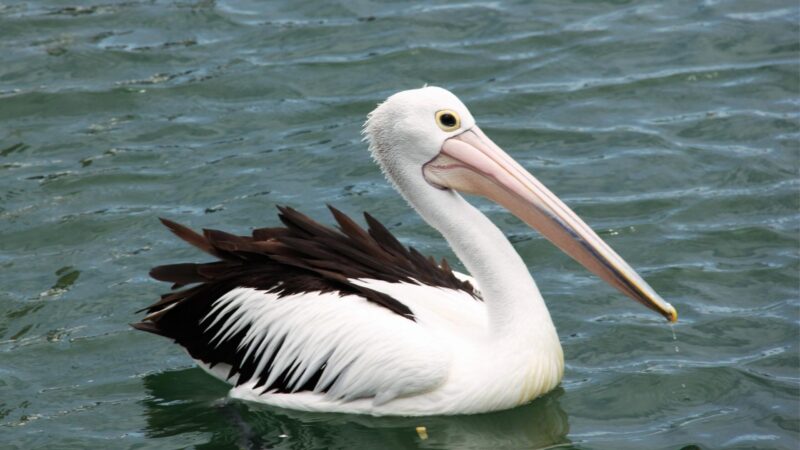
Known for being one of the largest flying birds with the longest bill, Australian Pelicans reside near bodies of water such as coastal inlets, lakes, interior rivers, and shorelines. They can occasionally be spotted perching on lamp-posts and are tame in the presence of human activity.
- Scientific Name: Pelecanus conspicillatus
- Appearance: Large flying bird with pouched bills, broad wings, long neck, short legs, and webbed toes
- Color: White overall plumage, black primary feathers on the wings and back, a pale pink pouched bill with a dark blue stripe, and gray legs and feet.
- Beak Length: 40 to 50 centimeters
- Lifespan: 15 to 25 years (wild), up to 50 years (captivity)
- Size: 1.6 to 1.9 meters
- Weight: 4 to 6.8 kilograms
- Diet: Mainly fish, but they also feed on crustaceans such as prawns, shrimp, and freshwater crayfish, as well as small reptiles, mammals, and amphibians.
- Place Of Origin: Australia
- Characteristics: Diurnal and highly social birds that flock in groups that can get as large as 40,000 individuals. They’re migratory, but only within their geographic range, and can travel long distances to find viable sources of food.
Toco Toucan
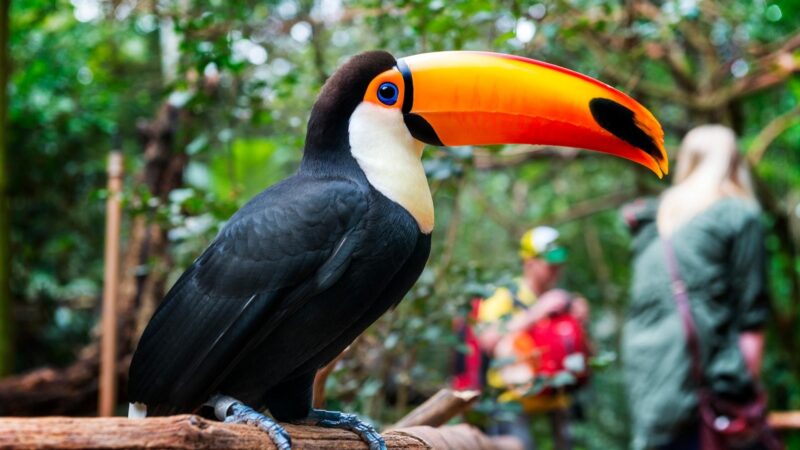
Toco Toucans are the largest toucan species, with their beak making up one-third of their total length. They’re loud communicators, producing a variety of repeated shrill croaking sounds. They’re also a popular pet choice with a recommended diet of fresh or dried fruit and insects.
- Scientific Name: Ramphastos toco
- Appearance: Large toucan with a large beak and long tail
- Color: Dominantly black plumage with a white throat and rump and a red undertail covert. The beak is yellow-orange in color with a distinctive black speck at the tip.
- Beak Length: 18 to 19 centimeters
- Lifespan: Up to 18 years (captivity), up to 26 years (wild)
- Size: 61 to 63.5 centimeters
- Weight: 592 to 760 grams
- Diet: Relies mostly on fleshy fruits, but they also feed on small vertebrates, large arthropods, and bird eggs such as those of the hyacinth macaws.
- Place Of Origin: South America
- Characteristics: Highly social and thrive in flocks made up of about 6 individuals. They’re considered nomadic as they constantly move to places with more fruits available.
European White Stork
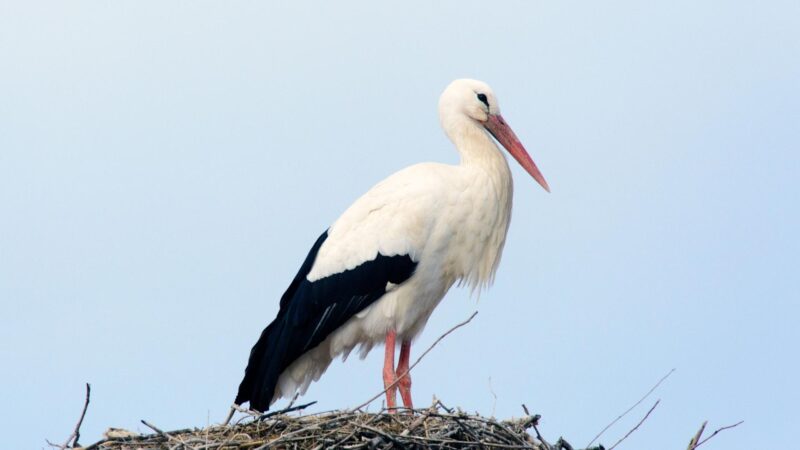
European white storks, or simply white storks, are found in open wetlands, agricultural fields, savannas, pastures, and meadows with shallow water that is neither too cold nor too humid. When flying, they have their legs and necks completely stretched and tend to glide during flight.
- Scientific Name: Ciconia ciconia
- Appearance: Large-sized wading birds with slender legs, long necks, and long, sharp beaks.
- Color: White plumage with black primary feathers found on its wings and wing coverts. Its beaks and legs are a bright orange color.
- Beak Length: 13 to 20 centimeters
- Lifespan: Up to 25 years (wild), up to 48 years (captivity)
- Size: 100 to 115 centimeters
- Weight: 5 to 10 kilograms
- Diet: Insects, crustaceans, hatchlings or eggs of birds that nest on the ground, scorpions, spiders, toads, rodents, frogs, snakes, lizards, and earthworms. In dry seasons, they primarily eat mice and insects. In wet seasons, they feed on insects and aquatic animals.
- Place Of Origin: Africa and Eurasia
- Characteristics: Relatively social, as they are usually found in groups made up of 40 to 50 individuals during the breeding season and can reach up to thousands of birds when migrating during the winter. They’re diurnal and not territorial.
Dalmatian Pelican
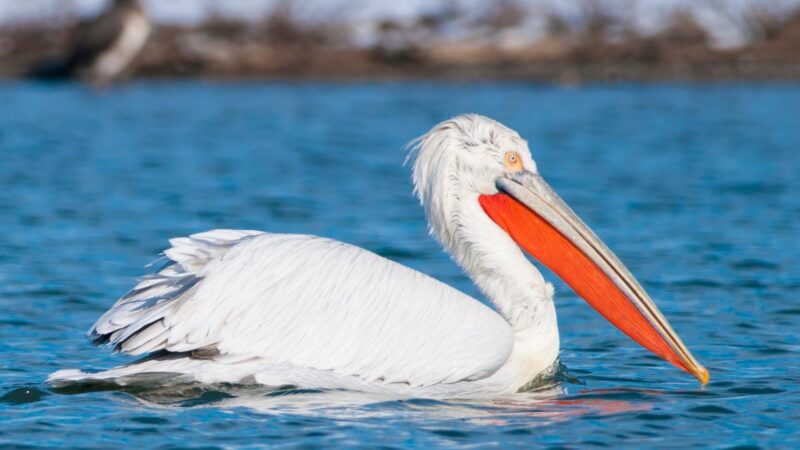
Dalmatian Pelicans are a distinguishable pelican species due to their scruffy appearance. They live in large flocks near rivers, estuaries, and extensive wetlands. According to the International Union for Conservation of Nature (IUCN), they’re classified as near threatened due to illegal hunting, pesticide use, and destruction of habitats.
- Scientific Name: Pelecanus crispus
- Appearance: Large-sized flying bird that has a disheveled appearance due to their distinctive curly neck feathers. It has webbed feet, a short tail, and short legs.
- Color: Dirty white plumage with black primary feathers that can only be seen during flight. They have pouched beaks that are bright orange during breeding seasons and yellow throughout the year. Contrary to other pelican species, its beak has no spottings, and its legs are a gray color.
- Beak Length: 36 to 45 centimeters
- Lifespan: 15 to 25 years (wild), up to 54 years (captivity)
- Size: 160 to 183 centimeters
- Weight: 7 to 15 kilograms
- Diet: Can eat up to 4 pounds of fish in a day, preferring larger-sized fish. Common species include eels, mullets, northern pikes, and catfish. They also feed on crustaceans, beetles, worms, and the nestlings and eggs of smaller water birds.
- Place Of Origin: Asia and Southern Europe
- Characteristics: Relatively social as they are found in loose colonies, especially during the breeding season, but can be found foraging and nesting alone. They’re also diurnal, territorial, and migratory. However, they only perform small to medium-length travels.
Great Spotted Kiwi
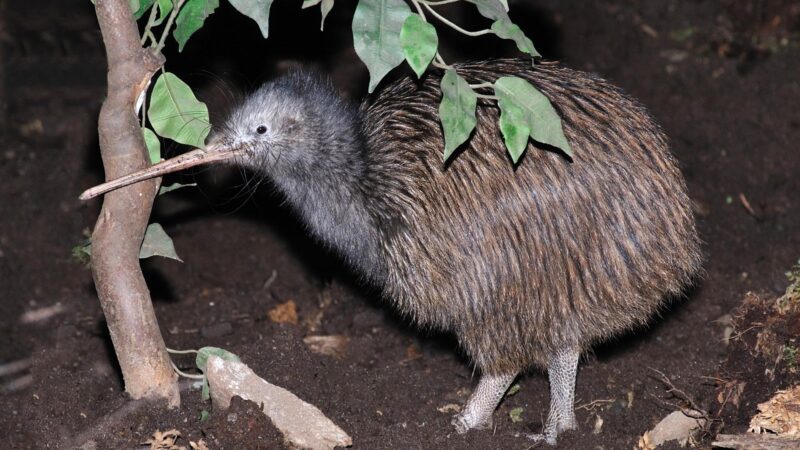
Great Spotted Kiwis are flightless birds that occur in forests, grasslands, and subalpine zones in New Zealand. Their high-pitched whistles make them easier heard than seen. They’re considered vulnerable according to the IUCN due to predation by mammals such as ferrets and ermine.
- Scientific Name: Apteryx haastii
- Appearance: A tall kiwi with small and soft vestigial wings, a stout and long bill, short but muscular legs, large toes, and no tail.
- Color: Feathers are an assortment of gray, off-white, and brown colors which give them an overall spotted, mottled, or horizontally banded plumage. Its beak is a white-gray color.
- Beak Length: 8.3 to 13.5 centimeters
- Lifespan: Up to 20 years (wild), 12 to 33 years (captivity)
- Size: 44 to 55 centimeters
- Weight: 2.4 to 3.3 kilograms
- Diet: Prefer seasonal fruits and seeds, but they mainly eat earthworms and other invertebrates such as spiders, beetles, and cicadas.
- Place Of Origin: New Zealand
- Characteristics: Solitary birds, unless during breeding and incubation seasons, but they also form temporary groups located around fruiting trees. They’re nocturnal and highly vocal, aggressive, and territorial.
Keel-Billed Toucan
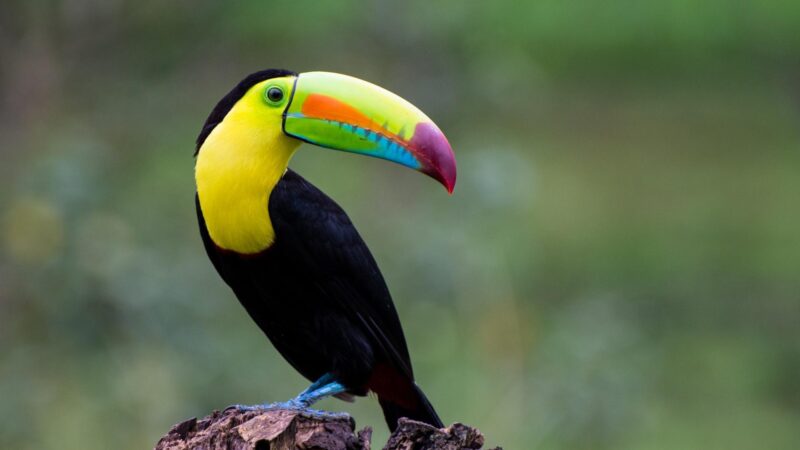
Known as the national bird of Belize and inhabitants of humid forests, Keel-billed Toucans are characterized by their bright beaks, which make up a third of their total size. Their beaks are lightweight, despite the heavy-looking appearance, due to their hollow keratin composition.
- Scientific Name: Ramphastos sulfuratus
- Appearance: Large toucan with a large banana-shaped beak edged with ridges that are tooth-like, long and square-shaped tail, short and wide wings, and toes arranged in a zygodactyl pattern wherein two toes are facing forward, and the other two toes are facing back.
- Color: Overall black plumage with a bright or neon yellow neck and chest, white rump, blue feet, and red undertail coverts. Its beak is an overall green color with a red tip on the upper mandible, a blue tip on the lower mandible, and bright orange sides.
- Beak Length: 13 to 20 centimeters
- Lifespan: 15 to 20 years (wild)
- Size: 43 to 56 centimeters
- Weight: 380 to 500 grams
- Diet: Primarily fruit, seeds, and berries of trees, such as the green fruit spikes of Cecropia and seeds of the plant genera Protium and Inga, and the tree Alchornea costaricensis. They also feed on insects, tree frogs, small lizards and snakes, and nestlings of other birds.
- Place Of Origin: Latin America
- Characteristics: Non-migratory, highly sociable bird, and is seen roosting, traveling, and feeding in flocks made of 6 to 12 individuals.
Rhinoceros Hornbill
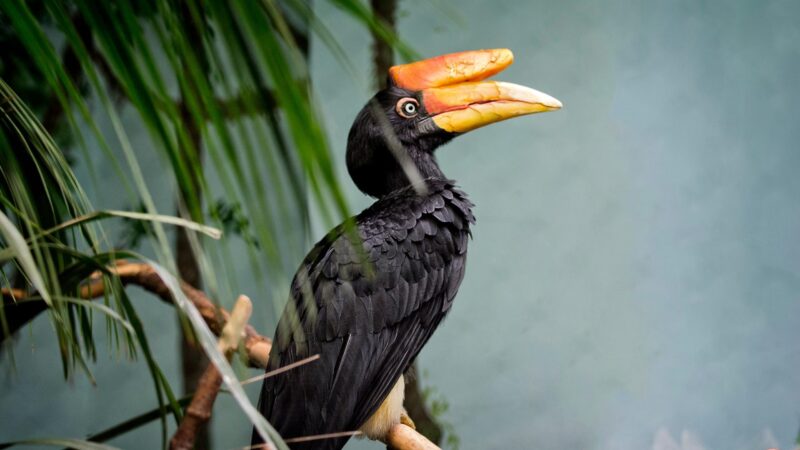
Rhinoceros Hornbills are characterized by their prominent “horns,” which are casques that are made of a hollow keratin structure. They’re extremely loud and noisy as they use their casques to amplify their calls. According to the International Union for Conservation of Nature (IUCN), they’re considered vulnerable species.
- Scientific Name: Buceros rhinoceros
- Appearance: A large bird with large, slightly recurved beaks that has a helmet-like structure, called a casque, on top of the base. Males have long and swept-up casques, while females are shorter and rectangular in shape.
- Color: Stark black plumage with a white rump and tail that’s banded with black. The beak and casque are a mix of yellow, orange, and red colors.
- Beak Length: 23 to 30 centimeters
- Lifespan: Up to 35 years (captivity)
- Size: 80 to 105 centimeters
- Weight: 2 to 3.4 kilograms
- Diet: Primarily fruits and figs, but they also feed on lizards, bird eggs and nestlings, tree frogs, and arthropods.
- Place Of Origin: Southeast Asia
- Characteristics: Relatively social birds as they gather in loose groups when feeding, but they’re mostly seen in pairs. They’re non-migratory, diurnal, and territorial, especially during the breeding season.
Great Hornbill
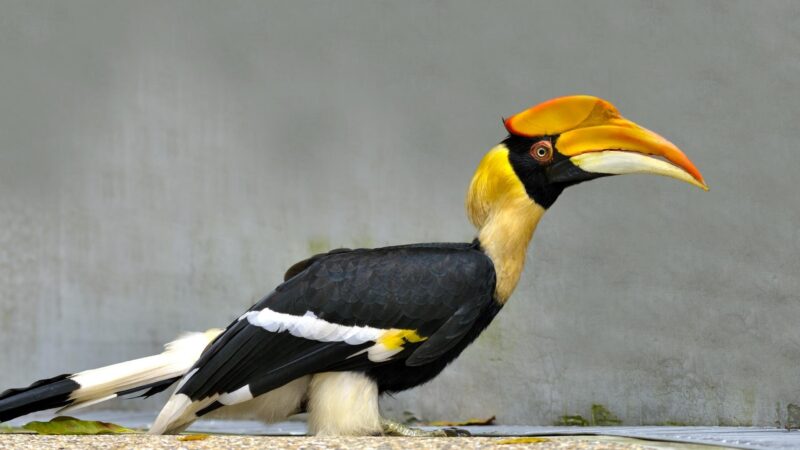
Found in dense evergreen forests, Great Hornbills have distinctive casques, but unlike the Rhinoceros Hornbills, they serve as for attracting potential mates and for fighting against other birds for dominance. According to the International Union for Conservation of Nature (IUCN), they’re a vulnerable species with a decreasing population trend.
- Scientific Name: Buceros bicornis
- Appearance: A relatively large bird with a large, downward-curving beak and a casque atop its head
- Color: Black overall plumage with a creamy white neck and abdomen. Its tail is white with a black band across, while its beak is of varying colors of yellow and red. During the flight, its wings have a yellowish band and white edge.
- Beak Length: 23 to 25 centimeters
- Lifespan: 35 to 40 years (wild), up to 50 years (captivity)
- Size: 95 to 120 centimeters
- Weight: 2 to 4 kilograms
- Diet: Primarily fruits that are rich in lipids and sugar, but they also eat insects, small mammals, reptiles, birds, and amphibians.
- Place Of Origin: Southeast Asia
- Characteristics: Relatively social as they thrive in small groups made of pairs and their offspring. They’re diurnal and non-migratory, but they will move in short distances within their geographic range. Males tend to fight during the breeding season.
Lesser Flamingo
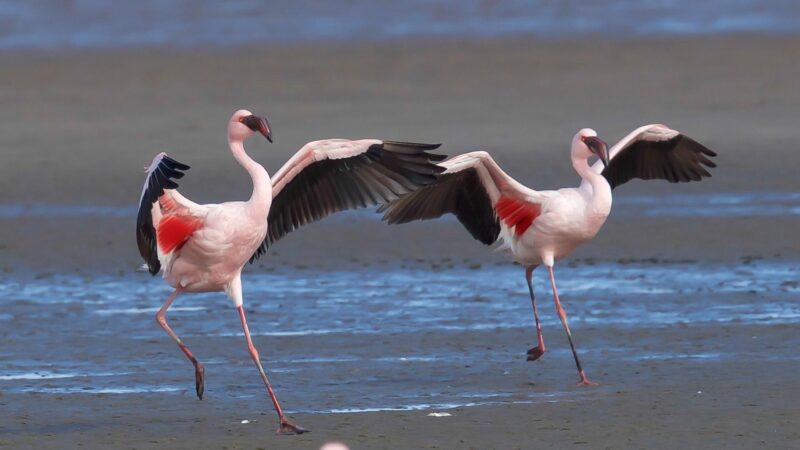
Lesser flamingos are the smallest of the 6 flamingo species and have the widest distribution. They live in wetlands and coastal areas, specifically near saline or alkaline lakes and estuaries. They’re sensitive to environmental changes such as the amount of rainfall and concentration of salt in their water.
- Scientific Name: Phoeniconaias minor
- Appearance: Tall and slender wading bird with a long s-shaped neck, angled beaks, thin legs, and webbed feet
- Color: Pink overall plumage, including its legs with black primary and secondary feathers on the wings and a dark red beak.
- Beak Length: 13 to 18 centimeters
- Lifespan: Up to 44 years (captivity), up to 80 years (wild)
- Size: 90 to 125 centimeters
- Weight: 1.5 to 1.8 kilograms
- Diet: Primarily alkaliphilic cyanobacteria, algae, copepods, diatoms, and planktons.
- Place Of Origin: Africa and Southern Asia
- Characteristics: Highly social animals that are usually found in large flocks where each bird will inform the rest of the flock of any signs of predation. They’re nomadic birds who can travel from one area to the next based on the availability and concentration of food. They’re also aggressive during the breeding season and are primarily active at dusk and dawn.
Shoebill
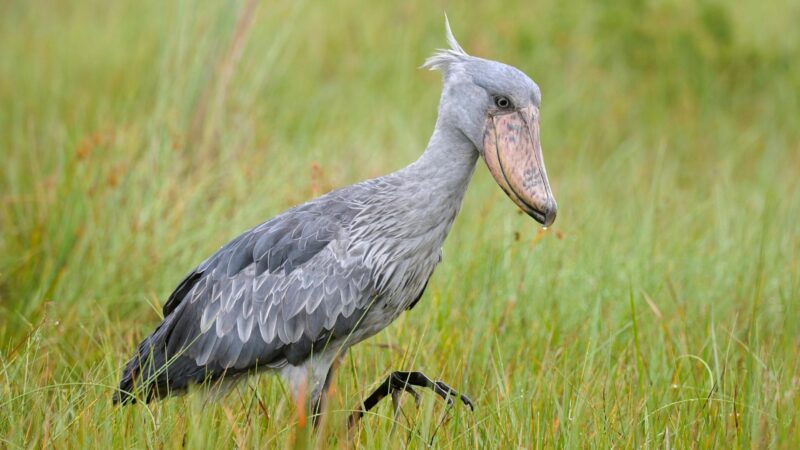
Shoebills, referred to as Whale-headed Storks, thrive in dense marshes and freshwater swamps with floating vegetation. They’re large, silent, and frightful-looking birds, but they’re very docile, not minding human presence.
- Scientific Name: Balaeniceps rex
- Appearance: Tall and large birds with a prominent sharp and curved beak that’s shaped like a wooden shoe, long legs, large eyes, and extremely long toes
- Color: Slate bluish-gray plumage with a dark gray head, light gray underparts, and a small, erect tuft of feathers located at the back of its head. Its primary feathers have black tips, while its secondary feathers have a greenish hue. The beak is yellowish in color with a splotch of dark spots.
- Beak Length: 24 centimeters
- Lifespan: Up to 35.7 years (wild), Up to 36 years (captivity)
- Size: 110 to 140 centimeters
- Weight: 4 to 7 kilograms
- Diet: Primarily fish such as catfish, lungfish, and tilapia, but they also consume turtles, mollusks, monitor lizards, frogs, young crocodiles, and carrion occasionally.
- Place Of Origin: Africa
- Characteristics: Territorial and extremely solitary unless breeding, but when food is scarce, these birds will forage close to each other. Non-migratory but will move in areas in their geographical range for better food or nesting.
Which Bird Has Longest Beak in the World?
The Australian Pelican has the longest beak in the world that can reach 40 to 50 centimeters in length. Coming in second is the Dalmatian Pelican, its sister species, with a beak that reaches 36 to 45 centimeters long.
What Happens if a Bird’s Beak Gets Too Long?
Birds with overgrown beaks will have a difficult time foraging and eating food. Those with severe deformities may even rely instead on feeders and other sources of food instead of foraging on their own, such as picking up scraps that were dropped by other birds.
Moreover, they will also have difficulty cleaning themselves through preening as they use their beaks for this process. Preening is also used to insulate the bird’s feathers and help them stay warm through cold seasons.
As a result, these birds may even die because they’re not consuming the required amount of food they need to survive, as well as not being able to stay warm during winter.
Is Beak Trimming Painful?
Beak trimming is painful. It can cause acute and chronic pain in birds that have their overgrown beaks trimmed since the tissues and nerves present in the beak will be damaged.
Do Beaks Grow Back?
Beaks do not grow back. They are cut permanently. However, regrowth may be possible.
Long beaks in birds are a result of their natural adaptation to their environment and as a means of survival. They use their beaks to forage, capture, and eat food and prey. Australian Pelicans have the longest beaks in the world, reaching 40 to 50 centimeters in length.
Overgrown beaks are harmful to the bird’s health as they will have difficulty eating and preening. Thus, they’re usually trimmed.
List of Sources
Beak Deformity’s Effects on Birds. (2018). U.S. Department of the Interior.
Long-billed Curlew. (1998). British Columbia – Ministry of Environment, Lands and Parks.
Crivelli, A. J. (1996). Action Plan for the Dalmatian Pelican (Pelecanus Crispus) In Europe. The Pennsylvania State University.
Pop Up Science – Bird Beaks! (2021). Biodiversity Institute & Natural History Museum.
Ragusa-Netto, J. (2008). Toco Toucan Feeding Ecology and Local Abundance in a Habitat Mosaic in the Brazilian Cerrado. The Neotropical Ornithological Society.
